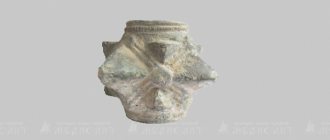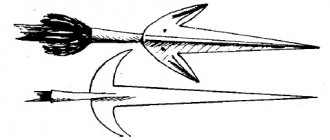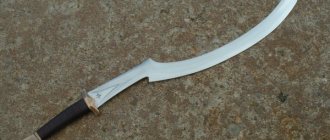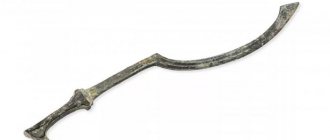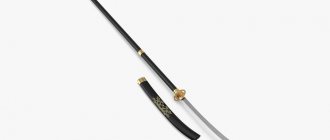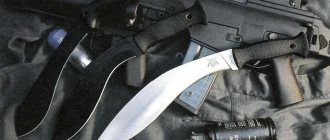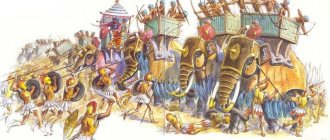Cold steel of the Indians
During the arrival of the whites, military maces became the most common Indian weapons. Iroquoian warriors used two types of wooden maces: for defense, topped with a heavy wooden ball; for attack, the ball replaced a pointed horn. The Prairie Indians used stone balls for maces.
The handle of the mace was wrapped in leather, so military maces were not the popular “military axes” that the Indians had known for a long time.
The whites “created” a weapon for them, which became, so to speak, the national weapon of the Indians - the famous tomahawk. Tomahawks supplied from European countries varied greatly in shape. The Indians learned to wield the tomahawk perfectly; it soon became their favorite weapon.
In North America, there were tribes whose representatives did not use bows and arrows even when hunting. The whites began to call one of these tribes “Sanz Arc” - literally “without bows”, “those who do not have bows”.
In addition to spears, military maces, tomahawks and bows, Indian warriors sometimes used knives. Before the arrival of the whites, metal blades were known only to the Indians of the northwestern coast of North America, who almost did not participate in the defensive battles of the inhabitants of the New World.
Other groups of North American Indians made knife blades from natural materials. The most interesting of these knives was the beaver knife of the Algonquian tribes of northeastern North America, the blade of which was a beaver tooth. Knife handles were usually made of wood, reed, flint or bone.
Indian bows
INDIAN BOWS
Until the end of the 19th century, the BOW and arrow remained the most important weapon of the red-skinned warrior. Before the advent of rapid-fire, breech-loading rifles, it was a very dangerous weapon in the right hands. One contemporary wrote in the late 1860s: “Even today the bow is used very widely, and although the Indian may acquire a gun, he is rarely seen without his longbow and quiver full of arrows. The gun may fail beyond his ability to repair, the cartridges may become damp... but the bow is always good and the fast arrows are ready to fire in wet or dry conditions. That’s why the savage always keeps a bow at hand.”
Indian bows can be divided into three types:
1. Simple, made from a single piece of hard, elastic wood. These were usually only used by children.
2. Strengthened with sinew, also made from a single piece of wood. The tendons were glued “so that they looked like bark.” The Blackfoot bow, which falls into this category and is described as a typical mid-19th century plains bow, was one meter in length.
3. Bows of the third type were made from the antlers of deer, bison or mountain sheep. They were the most powerful and expensive. If an ordinary Comanche wooden bow was valued at one horse, then a horn bow could cost a warrior a fortune - from six to twenty horses. According to anthropologist George Grinnell, horn bows were made mainly by the Crow and Rocky Mountain tribes - Shoshone, Ute and others, but they often traded them with other tribes. Typically, such a bow consisted of two or three (less often four) parts glued together. Bows made from a whole deer antler were considered extremely rare. The Comanches even sometimes used buffalo ribs, but according to the Indians, they were impractical. John Bradbury in 1811 saw various Indian bows and noted that the bow made from the horn of a mountain ram was considered the best. It was short but powerful. Bradbury saw a bow made from three pieces of horn neatly wrapped with sinew. The average length of the horn bows was about 90 centimeters.
Making bows was a man's job. Each warrior could make a bow for himself, but there were also specialists who were especially skilled in this. They were usually old men who had retired from military service. Sometimes it was a “family business”—among the Osage, for example, famous bowmakers came from the Hujoigara clan, which means “Only they wield the bow.”
Each person made the bow in his own way and different people used different methods as they saw fit. Fashion also changed - preference was given to one or another technique. But fundamentally the methods were the same throughout the Great Plains.
The length of wooden bows varied somewhat among lowland tribes. But usually it did not exceed 1.5 meters and was not less than 90 cm. The exception was the ponk bows, whose length was about 1.8 meters. “The length of their bows is quite large, as I have never seen an Indian bow longer than 4 feet,” Howard wrote. The Shoshone had the shortest bows, 75 cm. An interesting remark regarding the length of the bow was made by George Belden, who spent many years among the plains tribes: “Each bow differs in length and strength from another, depending on the needs of the owner.”
Making onions
According to Richard Dodge, it took a long time to make a good bow. He wrote: “The most highly valued bows among the Indians of central North America (Great Plains) were those made by carefully combining parts of deer antlers, glued together and tightly wrapped with strips of deer intestines or thin strands of sinew. The winding is first soaked, and when it dries, it tightly tightens and connects the individual parts into one whole. This produces a compact bow that is said to be stronger, tighter, more flexible and durable than a bow made from any other material. But the great difficulty of their manufacture, the fact that they become completely useless in damp and even humid weather, as well as the general use of firearms, led to the abandonment of these horn bows, and today they can be seen perhaps only in museums, or in influential families, where they are passed down from father to son like a family heirloom.”
Bowstring
The bow was always held with a lowered string, pulling it only when necessary, otherwise it would lose its elasticity and become unusable. At one end the bowstring was fastened tightly, and on the other side a pair of notches were made on which the loop of the other end of the bowstring was attached. Before using it, the Indian rested the bow on the ground with the end to which the string was tightly attached, and bent it with pressure until the loop fell into the notch. The Indians handled bowstrings very carefully so as not to damage them. Omahas always kept two strings with them - one on their bow and the other in their quiver in case the first one broke.
For the bowstring, all tribes used buffalo or deer tendons, running along the animal's spine from the shoulder blades to the sacrum. Some preferred to make bowstrings from horsehair because it did not break or absorb moisture. One of the Comanches said that he considered bear guts to be the best material for a bowstring.
Arrows
If the proportions of the arrow were not respected, it would be very difficult to hit the target. For example, a shaft that was too light or heavy significantly affected the flight of the arrow - a light one would deviate from the target, while a heavy one would hit a shorter distance, quickly losing its deadly power in flight. The Indians valued good arrows at a high price - ten arrows could cost one horse.
The arrow makers were usually old people or cripples who could not engage in activities typical for men. The old men made arrows for the men who lived under the same roof with them, who used them in war or hunting. The young men paid them for the opportunity to learn how to make good arrows.
The Mandans in 1929 remembered two crippled arrow makers (one had his leg broken by a wounded buffalo, the other's thigh shattered by a bullet) who lived by making and selling arrows all the time. Sioux White Hawk said that arrows were usually ordered from an arrow maker, a hundred at a time. When the Indian needed arrows, he collected the materials needed to make them, prepared food, and invited the old men to come and stay the whole day. One made the tips, another secured the feathers, the third painted them, etc. At the same time, they told stories about war or hunting, depending on what the arrows were intended for. They made six or twelve arrows, all of which were marked the same. The old man who painted them showed the marks to the others, so that later there would be no disputes about the ownership of the arrows. If subsequently someone claimed that these arrows belonged to him, the old men looked at the marks, recognized them, and settled the dispute.
Among the Poncas, everyone made their own arrow shafts, but the arrowheads for them were made by specialists who sold them to others. Among the Crows, on the contrary, the shafts were made by specialists.
The Comanches believed that the Cheyennes and Pawnees did not know how to make good arrows, while the arrows of the Comanches and Wichitas were highly valued.
Arrowheads
White Hawk, a Sioux from the Cheyenne River Reservation, said that he knew of three types of arrowheads:
1. Flint, which were used by his grandfather. He saw them as a child, but never used them himself.
2. Bone (from the inside of the ribs or brain bones of animals), which he used
his father.
3. Metal ones, which I used myself.
You can also note arrows without tips with a pointed or blunt end. But on the Great Plains, only children used them, hunting birds and small animals, or honing their skills on targets. Although there is evidence from the Spaniards that such arrows were very dangerous in the hands of southwestern tribes in the 17th century, the plainsmen did not use them in battles with enemies.
The Indians bought metal tips from traders or made them themselves from various scrap materials. Bradbury back in 1811 Fr. Belden wrote in the mid-19th century: “Almost all the savage tribes today use metal points, which are a serious source of income for traders. In the East, there are companies that produce hundreds of thousands of arrowheads every year and send them to traders to exchange with the Indians for furs... The arrowheads are sold in boxes of a dozen pieces each. They cost the merchant half a cent apiece, that is, six dollars per box, and by selling them to the Indians he makes a huge profit. A box is exchanged for a buffalo pelt, which costs 8-9 dollars, three tips are exchanged for a beaver pelt, which costs 4 dollars.”
The Arapaho bought iron for arrowheads and spears from the Mexicans. The Osage made them from iron, brass and copper. Also for these purposes, the Indians used frying pans sold by traders or captured from soldiers. “In those days, the pans used on the Plains were small, thin steel, with narrow, heavy steel handles and a hole in the end,” recalled Eugene Ware. One of his soldiers was wounded in a battle with the Cheyenne by an arrow tipped with a handle like this: “The Indian had a huge arrow, and almost 22 cm of frying pan handles, sharpened on the sides and pointed at the end, were attached to it as a tip. It entered the thigh several centimeters, piercing the femur.” It was reported that Mexican traders sold the Indians not only metal for the points, but also files with which the Redskins shaped and sharpened them. The Comanches, having made and sharpened the tip, strengthened it by heating it until red on a fire, and then dipping it into ice water.
The tip was inserted into the slot of the shaft and attached to it using homemade glue, after which it was immediately additionally wrapped with tendons. In securing it to the shaft, the Indian held the shaft in his right hand and the sinews in his left, turning the shaft with his fingers so that the sinews wound correctly around it. There were certain differences between combat and hunting arrows. they consisted in the shape of the tips and the methods of their attachment to the shaft. Hunting arrows had long cone-shaped tips, with a rounded back without teeth. The tip was firmly attached to the shaft, and the arrow was easy to pull out of the animal carcass. Combat arrows had lancet-like tips and teeth. In addition, they were weakly attached to the shaft. The teeth cut the wound from the inside and made it impossible to pull out the arrow. Usually there were two teeth - one on each “wing” of the tip. Comanches sometimes made just one prong. When pulled out, such a tip also rotated in the wound, making it impossible to remove it without surgical intervention. One prong was also often left by the Sioux, while the Cheyenne did not.
Due to the weak fastening, the tip remained in the wound when pulled out. Even if the tip did not have teeth, it posed a huge danger to the life of a wounded person. It could cause blood poisoning or move through tissue and damage vital organs. According to an American historian: “The Sioux war arrows were distinguished by longer tips and better processing. The tips of the Hunkpapa Sioux war arrows range from 11 to 13 cm in length, that is, 2-3 cm longer than usual, which, according to the Indians, gives them greater penetrating power.” Breckenridge in 1811 noted the difference between arrows depending on their use among the Arikara: “They have two kinds of arrows - one for hunting, the other for war. The latter are distinguished by the fact that the tip is attached to the shaft so weakly that when it penetrates the body, it remains there and cannot be pulled out along with the arrow. But if such an arrow hits soft tissue, it goes right through. They don’t use poisoned arrows.” John Bradbury pointed out that hunting arrows have wider tips so that more blood flows out of the animal and it gets tired faster during the chase. Both hunting and combat arrows had flat tips. However, since firearms became more accessible to the Redskins, the Indians probably no longer needed to make and use some arrows for hunting and others for war. Smith O.
Poisoned Arrows
In the early 19th century, some tribes on the Plains used poisoned arrows more often than most sources claim. Poison is known to have been used by the Shoshone in early times. To do this, they dipped arrowheads into a mixture of crushed ants and animal spleen, which they left to rot in the sun. The result was a deadly poison, and if the tip of such an arrow even scratched the skin of the enemy, he would certainly die. In addition, the Shoshone used rattlesnake venom. According to the Shoshone, the Plains Indians never used poisoned arrows, but Catlin mentioned that the Mandans used poisoned arrows. Wallace's informants reported that poisoned arrows were sometimes used by Comanches in the war. The poison was made from an unknown plant, or dipped into the insides of a dead skunk. George Belden especially about. He left a description of the method shown to him by the Teton Sioux's closest relatives, the Santee Sioux. The Indians caught a large rattlesnake and pinned its head to the ground with a forked stick, after which they lightly tickled it with a small branch from head to tail. This drove the snake into a wild rage. A fresh deer liver was placed next to it and released. The snake bit into her over and over again, stinging with poisonous teeth, and when it got tired, it was again pinned to the ground and tickled, and then released again and it again attacked the liver. Then the snake was killed, and the liver, strung on a sharp stick, was carried to the village. Soon it turned black and began to smell bad, which indicated its readiness. The Indians brought arrows, stuck them into the liver and left them there for half an hour, after which they pulled them out and dried them in the sun. One liver was enough for a thousand arrows. An arrow poisoned in this way only needed to scratch the skin to kill the enemy. They were treated extremely delicately, but sometimes due to carelessness horses, women, children and even warriors died because of them. Belden suggested that "the Indians abandoned their use for reasons of their own safety rather than for humanitarian reasons."
Firearms of the Indians
The first firearms came to the North American Indians only at the beginning of the eighteenth century. The main suppliers were representatives of fur trading companies. A particularly widespread exchange of furs for firearms was launched at that time by the famous Hudson Bay Company among the Indians of today's Canada. Later, the sale of firearms to Indians was radically limited.
They obtained it from individual traders, most often again in exchange for skins. Indian warriors also replenished their weapons from war trophies. So, despite numerous prohibitions, some tribes managed to “re-arm” in two or three generations.
For example, in a report about the Assiniboines, dated 1809, it is noted that this tribe, which at that time numbered 1,880 camps with two thousand combat-ready warriors, was armed with 1,100 firearms.
But as the number of firearms grew, so did the need for ammunition.
And since it was practically impossible to seize weapons from the Indians, the Americans, from the beginning of the 19th century, sought to minimize the sale of ammunition to them.
Every ounce of gunpowder, every cartridge had the price of gold for the Indians. Indian warriors obtained ammunition in a variety of ways. By attacking enemy convoys, and in days of peace again by secret exchange for furs.
Some even offered their wives to single whites for one or more nights.
VTAC tactical tomahawks
Only after 2000 were tomahawks finally revived. Andy Prisco decided to revive it, buying all the rights from old Peter La Gan. This time the focus was not only on the military; the new “Vietnamese tomahawk” was widely advertised among the civilian population.
Seeing the enormous popularity of tactical tomahawks, many leading American companies began to produce similar models. Hatchets are now available in several versions:
- Classic axes with a wooden handle. These are the models that Cold Still produces;
- Lightweight models with polymer handles;
- All-metal models, cut from a single sheet of metal, with pads in the handle area.
Beginning in 2003, the VTAC tactical tomahawk was included in the standard set of tools for entering premises, along with the crowbar and sledgehammer. Currently, even the Chinese produce a wide range of counterfeits for models of famous brands. Most often, fakes are made of soft metal, and their handles break quickly.
Indian armor
Traditional Indian warfare was also influenced by another “white man’s gift”—the horse. The animal that, in fact, created the prairie Indians, who later turned out to be the hardest nut to crack for the American army.
But even earlier, the Indians of Arizona, Texas, and New Mexico received horses from the Spaniards. The first horsemen were the Apaches. Following the example of the Spaniards, they began to dress their horses in leather “armor” (Apache warriors, by the way, used such leather “armor” for a long time for their own protection.
In general, Indian warriors protected themselves in battle with leather shields; the Indians of the northwest used helmets made of wood). The Apaches, thus having the best equipment for war, were later able, as the Jesuit Masne says in his message of 1691, to defeat all the neighboring tribes.
Why do modern military personnel need tomahawks?
Some people believe that modern militaries do not need axes. According to statistics, no more than 1% of soldiers die from bladed weapons in combat operations. In fact, an ax is a universal tool. With its help you can chop wood, open metal barrels, and break down a door. A long spike on the butt helps to make a hole in brick walls in order to plant explosives there. If necessary, a long steel spike will help you climb onto the same wall.
The design features of the hatchet make it a universal tool in any situation. It is for this reason that tactical tomahawks are so popular not only among the military, but also among “survivalists.”
